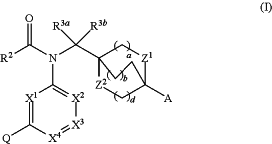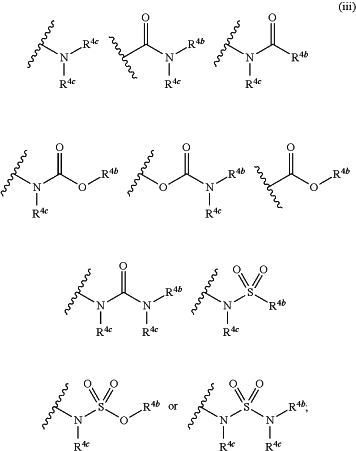| CPC C07C 233/61 (2013.01) [C07D 205/04 (2013.01); C07D 207/06 (2013.01); C07D 271/06 (2013.01); C07D 277/64 (2013.01); C07D 295/04 (2013.01); C07D 309/04 (2013.01); C07D 405/04 (2013.01); C07D 405/14 (2013.01); C07D 413/04 (2013.01)] | 15 Claims |
|
1. A compound of Formula (I):
 or a stereoisomer, a tautomer, or a salt or solvate thereof, wherein:
X1 is CR5a or N;
X2 is CR5b or N;
X3 is CR5c or N;
X4 is CR5d or N; provided that zero, 1, or 2 of X1, X2, X3, and X4 are N;
Z1 and Z2 are independently CH2 or O; provided that at least one of Z1 and Z2 is CH2;
a is zero or 1;
b is zero, 1, or 2;
d is zero, 1, or 2; provided that Z1 and Z2 are each CH2 when a, b, and d are each zero;
Q is C2-6 alkenyl or C2-6 alkynyl, each substituted with zero to 2 R1;
each R1 is independently —C(O)ORx, —C(O)NRxRx, or C1-4 hydroxyalkyl;
each R1a is independently halo, oxo, cyano, hydroxyl, —NH2, C1-6 alkyl, C1-6 alkoxy, —NH(C1-6 alkyl), —N(C1-6 alkyl)2, or —NRxC(O)(C1-6 alkyl), wherein each of said alkyl and alkoxy is substituted with zero to 6 R1b;
each R1b is independently halo, hydroxyl, —NRwRw, oxo, cyano, C1-3 alkoxy, C1-3 haloalkoxy, —C(O)ORx, —C(O)NRwRw, or —NRxC(O)Ry;
or when X1 is CR5a , Q and R5a can be joined together to form a —CR1a═CR1CH2CH2— bridge;
R2 is:
(i) C1-6 alkyl, C2-6 alkenyl, C2-6 alkynyl, C1-6 alkoxy, or —NRvRv, wherein each of said alkyl, alkenyl, alkynyl, and alkoxy is substituted with zero to 6 R2a;
(ii) C3-8 carbocyclyl, C6-8 spirobicyclyl, 4- to 7-membered heterocyclyl, phenyl, or 5- to 6-membered heteroaryl, wherein each of said carbocyclyl, spirobicyclyl, heterocyclyl, phenyl, and heteroaryl is substituted with zero to 3 R2b; or
(iii) —CH2(C3-6 cycloalkyl), —CH2(4- to 6-membered heterocyclyl), —NRx(CH2)0-2(C3-6 cycloalkyl), —NRx(CH2)0-2(C5-8 bicycloalkyl), —NRx(CH2)0-2(C5-8 spirobicyclyl), —NRx(CH2)0-2(4- to 6-membered heterocyclyl), —NRx(CH2)0-2(5- to 6-membered heteroaryl), —NRx(CH2)0-2(phenyl), —O(CH2)0-2(C3-6 cycloalkyl), —O(CH2)0-2(C5-8 bicycloalkyl), —O(CH2)0-2(C5-8 spirobicyclyl),—O(CH2)0-2(4- to 6-membered heterocyclyl), —O(CH2)0-2(5- to 6-membered heteroaryl), or —O(CH2)0-2(phenyl), wherein each of said cycloalkyl, heterocyclyl, bicycloalkyl, spirobicyclyl, aryl, and heteroaryl is substituted with zero to 3 R2b;
each R2a is independently halo, cyano, hydroxyl, oxo, C1-3 haloalkyl, C1-3 alkoxy, C1-3 haloalkoxy, —NRxRx, —C(O)(C1-6 alkyl), —C(O)(C3-6 cycloalkyl), —NRxC(O)Ry, —C(O)(C1-6 alkyl), —C(O)ORx, —C(O)NRwRw, —S(O)2Ry, —S(O)2(C1-3 fluoroalkyl), —NRS(O)2(C1-3 alkyl), —NRxS(O)2(C3-6 cycloalkyl), —S(O)2NRzRz, or —P(O)RyRy;
each R2b is independently halo, cyano, hydroxyl, oxo, C1-6 alkyl, C1-6 alkoxy, —NRxRx, —NRxC(O)O(C1-3 alkyl), —C(O)(C1-3 alkyl), or —S(O)2(C1-3 alkyl), wherein each of said alkyl and alkoxy is substituted with zero to 6 R2a;
R3a and R3b are independently hydrogen, C1-3 alkyl, C1-3 haloalkyl, or C3-6 cycloalkyl, or R3a and R3b; taken together with the carbon atom to which they are attached, form a C3-6 cycloalkyl;
A is:
(i) cyano;
(ii) phenyl or a 5- to 10-membered heteroaryl containing 1 to 4 heteroatoms independently selected from N, O, and S, wherein each of said phenyl and heteroaryl is substituted with zero to 3 R4a; or
 each R4a is independently halo, cyano, hydroxyl, —NH2, C1-6 alkyl, C2-6 alkenyl, C2-6 alkynyl, C1-6 alkoxy, —(CH2)0-3NH(C1-6 alkyl), —(CH2)0-2N(C1-6 alkyl)2, —(CH2)0-3(C3-6 cycloalkyl), or —(CH2)0-3(4- to 6-membered heterocyclyl), wherein each of said alkyl, alkoxy, alkenyl, and alkynyl is substituted with zero to 6 R4d and each of said cycloalkyl and heterocyclyl is substituted with zero to 3 R4e;
R4b is C1-6 alkyl, —(CH2)0-3(C3-6 cycloalkyl), or —(CH2)0-3(4- to 6-membered heterocyclyl), wherein each of said alkyl is substituted with zero to 6 R4d and each of said cycloalkyl and heterocyclyl is substituted with zero to 3 R4e;
each R4, is independently hydrogen, C1-6 alkyl, C3-6 cycloalkyl, 4- to 6-membered heterocyclyl, phenyl, or 5- to 6-membered heteroaryl;
each R4d is independently halo, hydroxyl, —NRxRx, oxo, cyano, C1-3 alkoxy, or C1-3 haloalkoxy;
each R4e is independently halo, oxo, cyano, hydroxyl, —NH2, C1-6 alkyl, C1-6 alkoxy, —NH(C1-6 alkyl), or —N(C1-6 alkyl)2, wherein each of said alkyl and alkoxy is substituted with zero to 6 R4d;
each of R5a, R5b, R5c, and R5d is independently hydrogen, halo, hydroxy, cyano, C1-6 alkyl substituted with zero to 6 R5e, C1-6 alkoxy substituted with zero to 6 R5e, —C(O)ORx, —C(O)NRwRw, —S(O)2Ry, —S(O)2NRzRz, or phenyl substituted with zero to 3 R5f;
each of R5e is independently halo, hydroxyl, —NRxRx, oxo, cyano, C1-3 alkoxy, or C1-3 haloalkoxy;
each R5f is independently halo, oxo, cyano, hydroxyl, —NH2, C1-6 alkyl, C1-6 alkoxy, —NH(C1-6 alkyl), or —N(C1-6 alkyl)2, wherein each of said alkyl and alkoxy is substituted with zero to 6 R5e;
each R is independently hydrogen, C1-6 alkyl, or alternatively, two R, taken together with the nitrogen atom to which they are attached, form a 4- to 7-membered bicyclic or spirocyclic ring moiety containing zero to 2 additional heteroatoms independently selected from N, O, and S, wherein each ring can be substituted with zero to 6 R2a;
each Rw is independently hydrogen, C1-6 alkyl, or C3-6 cycloalkyl; or alternatively, two Rw, taken together with the nitrogen atom to which they are attached, form a 4- to 7-membered ring moiety containing zero to 2 additional heteroatoms independently selected from N, O, and S;
each Rx is independently hydrogen, C1-6 alkyl, or C3-6 cycloalkyl;
Ry is C1-6 alkyl or C3-6 cycloalkyl; and
each Rz is independently hydrogen, C1-6 alkyl, or C3-6 cycloalkyl; or alternatively, two Rz, taken together with the nitrogen atom to which they are attached, form a 4- to 7-membered ring moiety containing zero to 2 additional heteroatoms independently selected from N, O, and S.
|